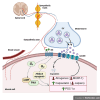Sympathetic innervation in skeletal muscle and its role at the neuromuscular junction
- PMID: 38367152
- PMCID: PMC11096211
- DOI: 10.1007/s10974-024-09665-9
Sympathetic innervation in skeletal muscle and its role at the neuromuscular junction
Abstract
Neuromuscular junctions are the synapses between motor neurons and skeletal muscle fibers, which mediate voluntary muscle movement. Since neuromuscular junctions are also tightly associated with the capping function of terminal Schwann cells, these synapses have been classically regarded as tripartite chemical synapses. Although evidences from sympathetic innervation of neuromuscular junctions was described approximately a century ago, the essential presence and functional relevance of sympathetic contribution to the maintenance and modulation of neuromuscular junctions was demonstrated only recently. These findings shed light on the pathophysiology of different clinical conditions and can optimize surgical and clinical treatment modalities for skeletal muscle disorders.
Keywords: Acetylcholine receptor; Adrenoceptor; Neuromuscular junction; Sympathetic.
© 2024. The Author(s).
Conflict of interest statement
The authors declare no competing interests.
Figures

Similar articles
-
Postnatal Development and Distribution of Sympathetic Innervation in Mouse Skeletal Muscle.Int J Mol Sci. 2018 Jul 1;19(7):1935. doi: 10.3390/ijms19071935. Int J Mol Sci. 2018. PMID: 29966393 Free PMC article.
-
Sympathetic innervation controls homeostasis of neuromuscular junctions in health and disease.Proc Natl Acad Sci U S A. 2016 Jan 19;113(3):746-50. doi: 10.1073/pnas.1524272113. Epub 2016 Jan 5. Proc Natl Acad Sci U S A. 2016. PMID: 26733679 Free PMC article.
-
The emerging role of the sympathetic nervous system in skeletal muscle motor innervation and sarcopenia.Ageing Res Rev. 2021 May;67:101305. doi: 10.1016/j.arr.2021.101305. Epub 2021 Feb 18. Ageing Res Rev. 2021. PMID: 33610815 Free PMC article. Review.
-
The sympathetic nervous system regulates skeletal muscle motor innervation and acetylcholine receptor stability.Acta Physiol (Oxf). 2019 Mar;225(3):e13195. doi: 10.1111/apha.13195. Epub 2018 Oct 22. Acta Physiol (Oxf). 2019. PMID: 30269419 Free PMC article.
-
Perisynaptic schwann cells - The multitasking cells at the developing neuromuscular junctions.Semin Cell Dev Biol. 2020 Aug;104:31-38. doi: 10.1016/j.semcdb.2020.02.011. Epub 2020 Mar 5. Semin Cell Dev Biol. 2020. PMID: 32147379 Review.
Cited by
-
Factors, mechanisms and improvement methods of muscle strength loss.Front Cell Dev Biol. 2024 Dec 4;12:1509519. doi: 10.3389/fcell.2024.1509519. eCollection 2024. Front Cell Dev Biol. 2024. PMID: 39698495 Free PMC article. Review.
-
Enhancing motor performance through brief skin cooling: exploring the role of enhanced sympathetic tone and muscle spindle sensitivity.Eur J Appl Physiol. 2025 Feb;125(2):443-453. doi: 10.1007/s00421-024-05597-x. Epub 2024 Sep 22. Eur J Appl Physiol. 2025. PMID: 39307853
-
Adrenergic Modulation of Acetylcholine Release at the Mouse Neuromuscular Junctions of Fast-Twitch Skeletal Muscle.Neurochem Res. 2025 May 12;50(3):162. doi: 10.1007/s11064-025-04415-w. Neurochem Res. 2025. PMID: 40353941 Review.
-
Muscle Aging Heterogeneity: Genetic and Structural Basis of Sarcopenia Resistance.Genes (Basel). 2025 Aug 11;16(8):948. doi: 10.3390/genes16080948. Genes (Basel). 2025. PMID: 40869996 Free PMC article. Review.
References
-
- Agduhr E. Sympathetic innervation of the muscles of the extremities. A histo-experimental study. Verhand D K Akad v Wetensch Amsterdam. 1920;20:1–34.
-
- Baviera AM, Zanon NM, Carvalho Navegantes LC et al (2007) Pentoxifylline inhibits Ca2+-dependent and ATP proteasome-dependent proteolysis in skeletal muscle from acutely diabetic rats. Am J Physiol Endocrinol Metab 292:E702-8. 10.1152/ajpendo.00147.2006. - PubMed
Publication types
MeSH terms
LinkOut - more resources
Full Text Sources

